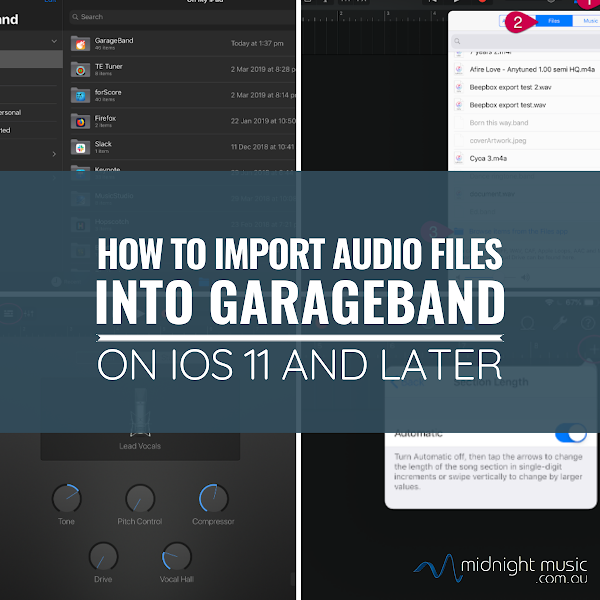GarageBand features a built-in tuner, accessed via the button to the right of the LCD display in the transport bar. This examines the incoming audio signal, whether it’s from a connected mic or guitar input, and displays its pitch on a circular readout, so you can use it to check whether your instrument is in tune before you record it. Import audio and MIDI files in GarageBand on Mac. You can import audio files of the following file types into a GarageBand project: AIFF. AAC (except protected AAC files) Apple Lossless. You can also import MIDI files into a GarageBand project. MIDI is a standard file format for synthesizers and other electronic music instruments. Importing a node creates an XmlNode object owned by the importing document, with Name and NodeType identical to the source node. The new object also has the attributes related to namespaces ( Prefix, LocalName, and NamespaceURI ). Pro Convert costs about. $390 on the street, and is currently a stand-alone application for Mac or PC. It allows you to open DAW projects, refine a few options, and (hopefully) spew them out as a different DAW's project or XML file. So, for example, it can open a Pro Tools PTF file, and convert it to a Cubase XML file.
 -->
-->On Windows devices, you can export Wi-Fi settings to an XML file, and then import these settings in Intune. Using these imported settings, you can create a Wi-Fi profile, and then deploy it to your devices.
This feature applies to:
- Windows 10 and newer
- Windows 10 desktop or mobile
- Windows Holographic for Business
- Windows 8.1 and newer
This article shows you how to export Wi-Fi settings from a Windows device, and then import these settings in to Intune.
Note
- On Windows 10 and newer, you can create a Wi-Fi profile directly in Intune. You don't have to import a file.
- For Windows 8.1 devices, you must export and import Wi-Fi settings to create and deploy Wi-Fi profiles.
Export Wi-Fi settings from a Windows device
Use netsh wlan to export an existing Wi-Fi profile to an XML file readable by Intune. On a Windows computer that has the WiFi profile, use the following steps:
- Create a local folder for the exported Wi-Fi profiles, such as c:WiFi.
- Open a command prompt as an administrator.
- Run the
netsh wlan show profilescommand. Note the name of the profile you'd like to export. In this example, the profile name is ContosoWiFi. - Run the
netsh wlan export profile name='ProfileName' folder=c:Wificommand. This command creates a Wi-Fi profile file named Wi-Fi-ProfileName.xml in your target folder. In our example, the file name is Wi-Fi-ContosoWiFi.xml.
Important
If you're exporting a Wi-Fi profile that includes a pre-shared key, you must add
key=clearto the command. The key must be exported in plain text to successfully use the profile. For example, enter:netsh wlan export profile name='ProfileName' key=clear folder=c:WifiUsing a pre-shared key with Windows 10 causes a remediation error to show in Intune. When this happens, the Wi-Fi profile is properly assigned to the device, and the profile works as expected.
If you export a Wi-Fi profile that includes a pre-shared key, be sure the file is protected. The key is in plain text. It's your responsibility to protect the key.
Import the Wi-Fi settings into Intune
Sign in to the Microsoft Endpoint Manager admin center.
Select Devices > Configuration profiles > Create profile.
Enter the following properties:
Platform: Select Windows 8.1 and later.
Even though you select Windows 8.1, this feature still applies to Windows 10 and Windows Holographic.
Profile: Select Wi-Fi import.
Select Create.
In Basics, enter the following properties:
- Name: This setting is the profile name. You must enter the same name as the
nameattribute in the Wi-Fi profile xml. If you enter a different name, the profile will fail. - Description: Enter a description for the profile. This setting is optional, but recommended. For example, enter
Imported Wi-Fi profile for Windows 10 Holographic devices.
- Name: This setting is the profile name. You must enter the same name as the
Select Next.
In Configuration settings, enter the following properties:
- Connection name: Enter a name for the Wi-Fi connection. This name is shown to users when they browse available Wi-Fi networks. For example, enter
ContosoWiFi. - Profile XML: Select the browse button, and select the XML file that contains the Wi-Fi profile settings you want to import.
- File contents: Shows the XML code for the XML file you selected.
- Connection name: Enter a name for the Wi-Fi connection. This name is shown to users when they browse available Wi-Fi networks. For example, enter
Select Next.
In Scope tags (optional), assign a tag to filter the profile to specific IT groups, such as
US-NC IT TeamorJohnGlenn_ITDepartment. For more information about scope tags, see Use RBAC and scope tags for distributed IT.Select Next.
In Assignments, select the user or groups that will receive your profile. For more information on assigning profiles, see Assign user and device profiles.
Select Next.
In Review + create, review your settings. When you select Create, your changes are saved, and the profile is assigned. The policy is also shown in the profiles list.
Next steps
The profile is created, but may not be doing anything. Be sure to assign the profile, and monitor its status..
Garageband Xml Import Command

Garageband Xml Import Free

Garageband Xml Import File
See the Wi-Fi settings overview, including other available platforms.